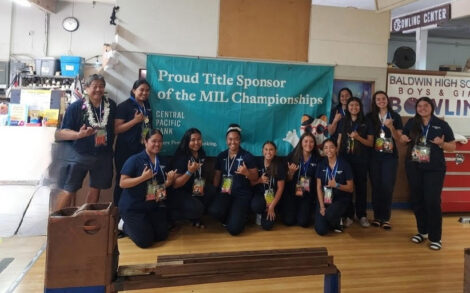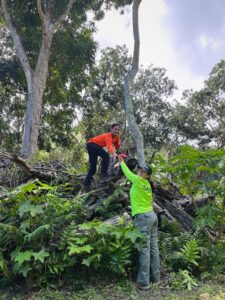Lanai bowling alley saga shines light on county’s cumbersome parking mandates
Maui County lawmakers have approved a bill that clears the way for a new four-lane bowling facility in the heart of the island’s “downtown” area. But the project’s almost-two-year saga of obtaining its regulatory clearances is a striking example of how the county’s inflexible zoning mandates can delay or even possibly block much-desired community projects.
The estimated $5 million project was initiated in May 2023 by land-management company Pūlama Lānaʻi. Its plan was to tear down an old government building at Dole Park — once used as a bowling alley itself — and build a new bowling center, complete with an arcade, full-service kitchen and soda fountain bar.
But almost immediately, the company ran into permitting problems, the main one being a county mandate requiring that the project include 42 new parking stalls at a cost of about $1 million — even though 108 public parking spaces already surround the site.
In addition to the added construction costs, the mandate would also have required Pūlama Lāna’i to pave over part of Dole Park, including several mature Cook pine trees.
To avoid having to do this, the company sought a parking-reduction waiver from the Maui Planning Department.
County zoning rules allow up to a 50% reduction in the amount of required stalls under certain circumstances, one of which relates to publicly available off-street parking being located within 500 feet of the proposed project.
That request was approved in May 2024 — more than a year after Pūlama Lānaʻi initially applied for the demo permit — and reduced the requirement from 42 to 21 stalls.
In order to move the remaining 21 stalls out of Dole Park, Pūlama Lānaʻi filed for an off-site parking permit that would reserve 13 stalls across from Dole Park in front of the Lanai Culture & Heritage Center — aka the “former Dole Admin building” — and seven stalls in front of the First Hawaiian Bank building exclusively for the new bowling center.
In addition, a single stall would be built in front of the bowling alley to comply with the federal Americans with Disabilities Act. In response to these requirements, Maui County Council Member Alice Lee introduced Bill 21 (2025). At a Sept. 3 Council committee hearing for the measure, Councilmember Gabe Johnson, who represents Lanai, voiced support for the bill. “I think the idea of all these parking stalls is a little bit overkill,” he said. “That’s the center of town. … Let’s keep it as good and original as we can, with the same old-school vibes.”
Approved by the Council on Oct. 10 and signed into law by Mayor Richard Bissen on Oct. 13, the measure exempts Dole Park from the county’s off-street parking requirements and aligns its zoning treatment with all other properties in Lanai City’s “business country town” zoning district.
Ideally, this will enable Pūlama Lānaʻi to follow through on its plans to build the new bowling alley and help Lanai residents to once again enjoy the social and physical benefits of bowling, which they have not been able to do on-island since the old bowling alley closed in the late 1970s.
It took almost two years.
Other parking-reduction requests throughout the county have not been so lucky. According to Maui’s Planning & Permitting System, the county has denied five out of 62 applications since 2000, leaving those rejected projects to face higher costs or refrain from building at all.
Looking at the broader picture, Maui County lawmakers should consider repealing or reforming parking mandates for all commercial and recreational buildings throughout Maui County.
Honolulu’s reforms are one example of how this could be accomplished. The city has reduced its parking mandates several times over the past decade to facilitate more affordable housing, and new research suggests that its liberalized parking rules have made it easier and more economical to provide such homes.
For Maui County residents, reducing or eliminating parking mandates could be a way to facilitate the construction of both new housing and new commercial and community-focused buildings — such as the new bowling alley on Lanai — without adding building costs, threatening the environment or detracting from an area’s historic charm.
Ahryanna McGuirk is a research associate at the Grassroot Institute of Hawaii.

Ahryanna McGuirk. Photo courtesy Grassroot Institute of Hawaii



